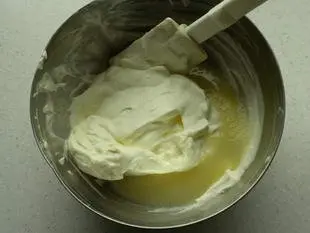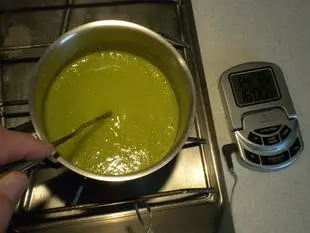Fruits which can ruin your jelly

There are many ways of making a fruit mousse, but one of the simplest is to prepare a fruit jelly (basically a fresh fruit coulis with gelatine) and then mix this jelly before it sets completely with whipped cream.
The result is perfect for filling a charlotte, for example.
But do beware; there are some fruits for which this will not work: kiwis, pineapple, mango and figs, in particular. You can add any amount of gelatine you like and the jelly will never set!
The result is perfect for filling a charlotte, for example.
But do beware; there are some fruits for which this will not work: kiwis, pineapple, mango and figs, in particular. You can add any amount of gelatine you like and the jelly will never set!
78 K 4.0/5 (32 reviews)
Keywords for this post:JellyGelatinMousseFruitKiwiLast modified on: March 6th 2013
Fruits which can ruin your jelly
And it can't set because these fruits contain enzymes called proteases, such as bromelain or papain, which prevent the gelatin from setting. So you cannot just make a straightforward kiwi or pineapple jelly.
Fortunately, science comes to the rescue and explains that it is possible to neutralise the effects of these bothersome proteases. We call this denaturing. All that is necessary is to heat the fruit to 60°C.
So, to make a pineapple jelly, for example, you simply need to heat the coulis over low heat to 60°C, add the gelatine, then leave to cool.
Even so, you should note that for a kiwi jelly, you should take care not to overheat the coulis if you wish to preserve the lovely green colour of the fruit. If it is overheated, the colour will turn dull, then brown. A thermometer is essential to ensure that the right temperature is reached but not exceeded.
As a last resort, you can use another jelling agent, such as carragheen.
Fortunately, science comes to the rescue and explains that it is possible to neutralise the effects of these bothersome proteases. We call this denaturing. All that is necessary is to heat the fruit to 60°C.
So, to make a pineapple jelly, for example, you simply need to heat the coulis over low heat to 60°C, add the gelatine, then leave to cool.

Even so, you should note that for a kiwi jelly, you should take care not to overheat the coulis if you wish to preserve the lovely green colour of the fruit. If it is overheated, the colour will turn dull, then brown. A thermometer is essential to ensure that the right temperature is reached but not exceeded.
As a last resort, you can use another jelling agent, such as carragheen.
Lasts posts
Oven height
When we put a dish or cake in the oven, we naturally tend to put it on the middle shelf, and that's what we usually do. But in some cases, this position and height can be a little tricky, so let's find out why.October 8th 20252,0255
The importance of sieving
In recipes that use a fine powder (flour, powdered sugar, etc.), you'll often see the advice to sift before using it. To sift is to pass the powder in question through a sieve (a very fine strainer) before incorporating it into your recipe. It's often advice, but is it really useful?September 3rd 20257,1333
The grease spray
As soon as you have something in a recipe that sticks to the mold, the question always arises as to how difficult it is to remove from the mold. There's nothing more frustrating than breaking your cake when unmolding it, because part of it has stuck in the mold. The classic way to avoid this is...August 26th 20256,6355
Cake moulds
When we make a cake, or a cake of the same rectangular shape, we usually take out our usual mould and tell ourselves that the recipe is anyway "for a cake", but is it really that simple?August 25th 20256,6895
Thinning out herbs
If you need to add a long-stemmed herb (tarragon, mint, verbena, thyme, etc.) to a recipe, you'll probably only need the leaves and not the stem, so you'll need to remove the leaves. Leaf removal means keeping only the beautiful leaves, and eliminating the ugly stems and leaves, but how do you do...August 8th 20254,8235
Other pages you may also like
Raising (or leavening) agents
When we want to make a dough or batter rise when baking, either in patisserie or bread-making, we need to use a raising agent or leavening agent, one of which is called leaven. In the context of baking, a raising agent is simply what "makes something rise". It is a substance which, when added to...June 16th 202157 K4.8
Cream and sauces
Have you ever wondered why making beautiful tasty sauces is so easy when you use cream? .October 15th 201223 K4.4
Candied fruits: don't get ripped off
Do you like candied fruit? You might like to nibble a handful or add it to a recipe, like a classic fruit cake or delicious Italian specialities like panettone or sicilian epiphany pie.June 21th 201766 K 24.2
A few tips for effective kneading at home
When you have to knead dough for bread or some other recipe, you may well use a food processor or the type of machine known as a stand mixer. The best-known brands are Kenwood and KitchenAid. They are useful tools, but here are a few tips to help you get the best out of them.June 23th 2021283 K 23.8
Drawing a pattern in pastry
Often in the kitchen, in pastry-making, or in baking, we need to trace a pattern on a pastry. It's just a question of aesthetics but it has its effect after baking on a galette, pithiviers, pâté en croute (terrine in a pie crust), etc.May 23th 201934 K4.1
Post a comment or question
Follow this page
If you are interested in this page, you can "follow" it, by entering your email address here. You will then receive a notification immediately each time the page is modified or a new comment is added. Please note that you will need to confirm this following.
Note: We'll never share your e-mail address with anyone else.
Alternatively: you can subscribe to the mailing list of cooling-ez.com , you will receive a e-mail for each new recipe published on the site.









